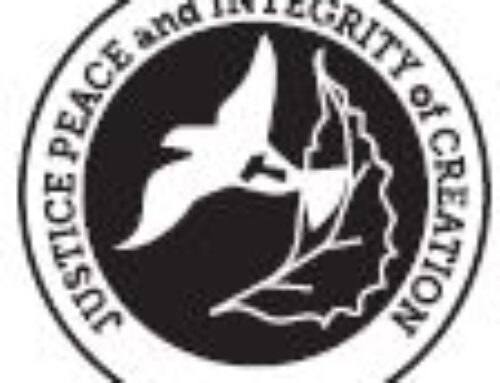(This article originally appeared in the TAU-USA Spring 2023 Issue #109)
by Bret Thoman, OFS

Confirmation of the Rule by Giotto, 1297-1300, Assisi
This year, 2023, the Franciscan Family will commemorate the 800th anniversary of the confirmation of the Later Rule. Also known as the Approved Rule, or the Rule of 1223, the papal approval of the Rule marks the culmination of a long and difficult journey for St. Francis. His journey can be an example to those of us who have professed a different rule, the Rule of the Secular Franciscan Order.
A rule is a commitment to live a particular religious form of life. It is conceived when one feels a calling. Then it is developed over time through prayer and discernment in fidelity to God, as well as in obedience to one’s superiors and the Church.
The beginning of the Rule of St. Francis can be traced to February 24, 1208. On that day, he received his calling to Gospel poverty. He was at Mass at the church of St. Mary of the Angels when the priest read from the Gospel of St. Matthew: “Do not take gold or silver or copper for your belts; no sack for the journey, or a second tunic, or sandals, or walking stick” (10:9-10).
Francis responded, “This is what I want to do with all my strength.” (See Legend of the Three Companions, Chapter VIII, 25.) His heart was set ablaze as he realized what he was called to do. Total, radical poverty was his charism.
If St. Francis was called by God to embrace poverty, how he would do so would be worked out over time. His charism was not given within a vacuum; it would be lived within the milieu of the thirteenth century and the canonical structure of the Catholic Church. Moreover, he would have to contend with the humanity of the other friars. Angels were not joining his order; men were.
Fr. Murray Bodo, OFM, narrates this dichotomy brilliantly and poetically. He introduces these two aspects in the title of his masterpiece biography of St. Francis, The Journey and the Dream. The “Dream” is Francis’ calling to poverty; the “Journey” is the struggle he faced as he dealt with the myriad challenges in implementing it. The journey would take 15 years.
Soon after receiving his calling, others from Assisi began following St. Francis. In the beginning, there was little guidance to direct the fledgling community. There was essentially one rule the friars had to abide by. It was directly from Scripture: “If you would be perfect, go, sell what you possess and give to the poor, and you will have treasure in heaven; and come, follow me” (Matthew 19:21).
This verse was revealed when Francis’ first companion, Bernard of Quintavalle, asked to follow him. In the church of San Nicolò, the two opened the Bible at random and, guided by the Holy Spirit, came upon that verse. They opened the Scriptures two more times and read: “Take nothing for your journey” (Luke 9:3) and “If any man would come after me, let him deny himself and take up his cross daily and follow me” (Luke 9:23). (See Little Flowers of Saint Francis, Chapter 2.)
After this, according to Thomas of Celano, “Bernard immediately carried out all these things, without neglecting a single iota of this counsel. In a short time, many turned away from the weary cares of the world toward an infinite Good, returning to their homeland with Francis as their guide.” (The Remembrance of the Desire of a Soul, Second Life, Chapter X, 15.)

Hermitage of Fonte Colombo where St. Francis wrote the Rule of 1223
When Francis had 12 followers, he discerned that his fledgling community needed more guidance. He wrote what is known as the Protorule, or primitive Rule, and went to Rome seeking papal approval from Pope Innocent III.
Thomas of Celano described the event: “When blessed Francis saw that the Lord God was daily increasing their numbers, he wrote for himself and his brothers present and future, simply and in few words, a form of life and a rule. He used primarily words of the holy Gospel, longing only for its perfection. He inserted a few other things necessary for the practice of a holy way of life.” (The Life of Saint Francis, First Life, Chapter XIII, 32).
This initial rule has not been preserved. It is believed that it consisted of the scriptural verses revealed to Francis and Bernard of Quintavalle, a promise to live the evangelical counsels, and a commitment to poverty. What is certain is that Francis did not take any of the existing monastic rules – which were essentially either Augustinian or Benedictine in the West. His form of life was radically new. He wished to base his life according to the Gospel life of Christ and the Apostles.
Pope Innocent III accepted Francis’ rule, though not without some hesitation. April 16, 1209, is given as the date on which the Franciscan Order was constituted and the Protorule was approved orally by the Pope.
Over the following years, Francis led the Order by example. The men who entered the Order did so in large part because of him, and the Franciscan way of life was modeled after the figure of St. Francis. However, it was increasingly apparent that more structure was necessary. Twice a year, the friars gathered in Assisi in what became referred to as chapters. They discussed “how they could better observe the Rule. […] Saint Francis, however, used to give admonitions, corrections, and directives as it seemed to him to be according to the Lord’s counsel.” (See Legend of the Three Companions, Chapter XIV, 57.)
In time, the Franciscan model began to change. As the Order grew in numbers and the known world was divided into provinces, men joined who had never met Francis or been to Assisi. Many had unique ideas and notions about the Franciscan way of life. When Francis was away in the Holy Land from 1219-20, the order moved farther from the vision of the founder.
For these reasons, Francis decided to formulate a much more comprehensive form of life. In a document consisting of 23 sections, he wrote the second rule – also known as the Earlier Rule, or the Rule of 1221. However, it did not meet the expectations of the friars. Moreover, its regulations were ambiguous, and it was not presented in sufficiently legal terminology. Therefore, Francis set out to crab another rule once again.
In 1223, he went with Brother Leo and Brother Bonizo to a hermitage near the city of Rieti, known as Fonte Colombo. Aber praying and fasting for forty days, he emerged with the final rule.
St. Bonaventure described the moment:
Since he therefore wanted the Rule that had been taken from a more widespread collection of Gospel passages to be confirmed, he went up to a certain mountain led by the Holy Spirit, with two of his companions, to condense it into a shorter form as the vision had dictated. There he fasted, content with only bread and water, and dictated the rule as the Holy Spirit suggested to him while he was praying. […] Fervently exhorting the brothers to observe this rule, Francis used to say that nothing of what he had placed there came from his own efforts but that he dictated everything just as it had been revealed by God. (The Life of Blessed Francis, Greater Legend, Chapter Four)
Pope Honorius III approved the Rule in a papal bull, Solet annuere, on November 29, 1223.
At first glance, the Rule of 1223 may appear technical or legalistic. However, it was unique, as it was different from the other traditional rules of the day. Moreover, it fully encompassed the vision St. Francis had for his Order, and he was fiercely devoted to it. In 1226, he wrote his Testament:
And I strictly command all my cleric and lay brothers, through obedience, not to place any gloss upon the Rule or upon these words saying: “They should be understood in this way.” But as the Lord has given me to speak and write the Rule and these words simply and purely, may you understand them simply and without gloss and observe them with a holy activity until the end. And whoever observes these things, let him be blessed in heaven with the blessing of the Most High Father, and on earth with the blessing of His Beloved Son with the Most Holy Spirit, the Paraclete, and all the powers of heaven and with all the saints. (38-40)
Shortly after writing the Testament, St. Francis died. As he lay dying, he said, “I have done what is mine; may Christ teach you what is yours!” He had a peaceful death, knowing that he had remained faithful to the charism he received when he was a young man. He lived his life according to the words God revealed to him, “Take nothing with you for the journey.” Through tenacity and perseverance, his “dream” was greater than the obstacles and challenges he faced on the “journey.”
As we reflect on St. Francis and his calling and commitment to the Rule, may we find inspiration as we consider our own calling.
Take a few moments to consider the following questions:
- When and how did you hear your calling to the Secular Franciscan Order?
- What was the “dream” like?
- How have you been faithful to your calling?
- What has the “journey” been like?
- What have the challenges been like?
May we, as Secular Franciscans, be confident we know and have done “what is ours!”




[…] from the Aug 27th meeting. As part of the meeting also, Andrew Mangravite did a presentation on the Rule of the Secular Franciscan Order (affectionately known as the little red rule book). This 2023, we are celebrating the 800th […]
I have grown up in an extended family who are very devoted to the faith. I was also a crib Catholic as well as my husband and grown children. It seems I am trying to do things like becoming a special education teacher, mom, helping with the Kroger, and working with the families that need care for a loved one. I constantly have failed. I am wanting to find my way. I have started to make my life simple., listen to Father Mike . I am now diagnosed with Dementia, Alzheimer’s. The simple life seems right.
I give back to God by making blessed baby blankets
Lisa Bonefas, bonefasla@yahoo.net